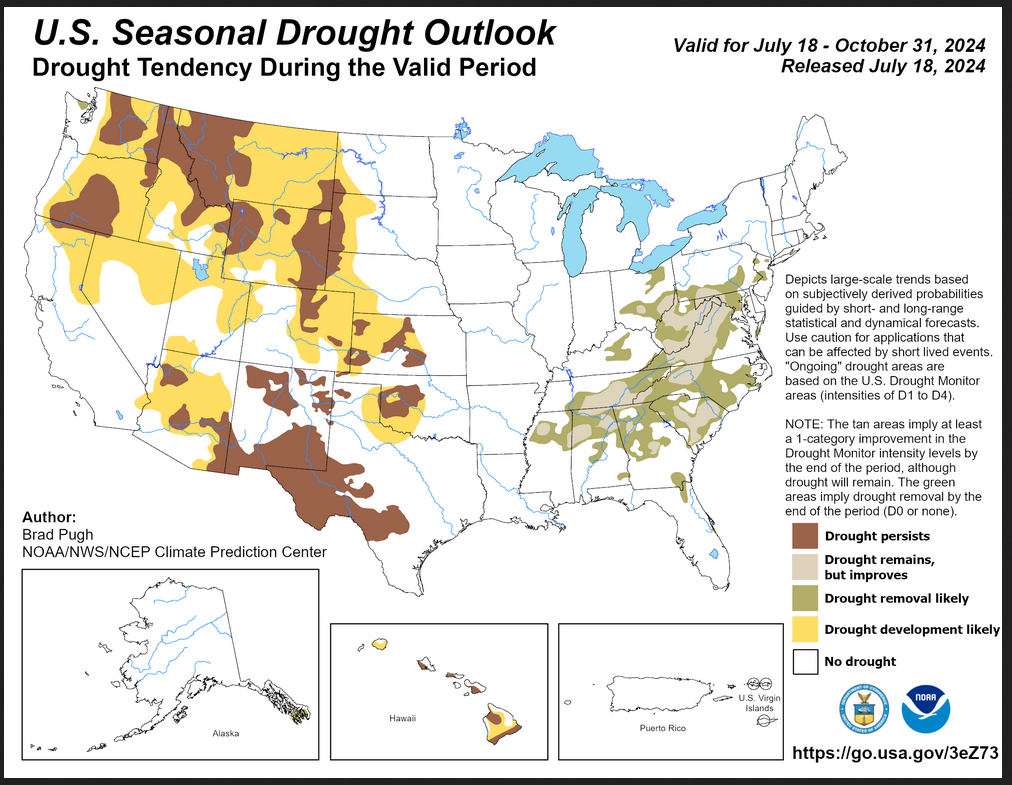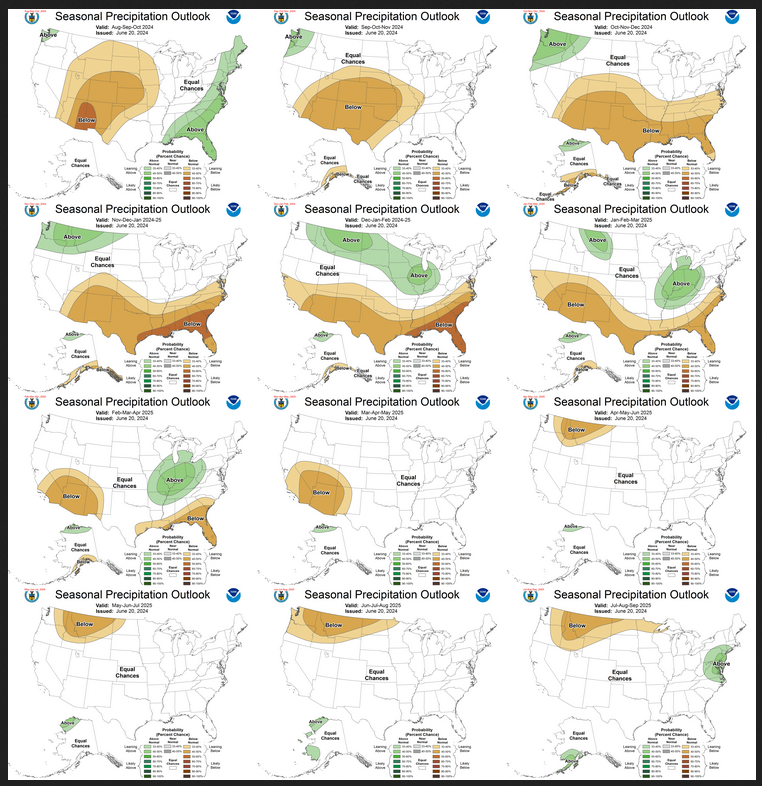On the third Thursday of the month right on schedule NOAA issued their updated Seasonal Outlook which I describe as their Four-Season Outlook because it extends a bit more than one year into the future. The information released also included the Mid-Month Outlook for the following month plus the weather and drought outlook for the next three months. I present the information issued by NOAA and try to add context to it. It is quite a challenge for NOAA to address the subsequent month, the subsequent three-month period as well as the twelve successive three-month periods for a year or a bit more.
With respect to the long-term part of the Outlook which I call the Four-Season Outlook, the timing of the transition from Neutral to LaNina is challenging to predict. We are now in ENSO Neutral. La Nina is the likely scenario for this summer almost to the end of the forecast period.
First, Let’s Take a Look at the (mid-month) Outlook for August
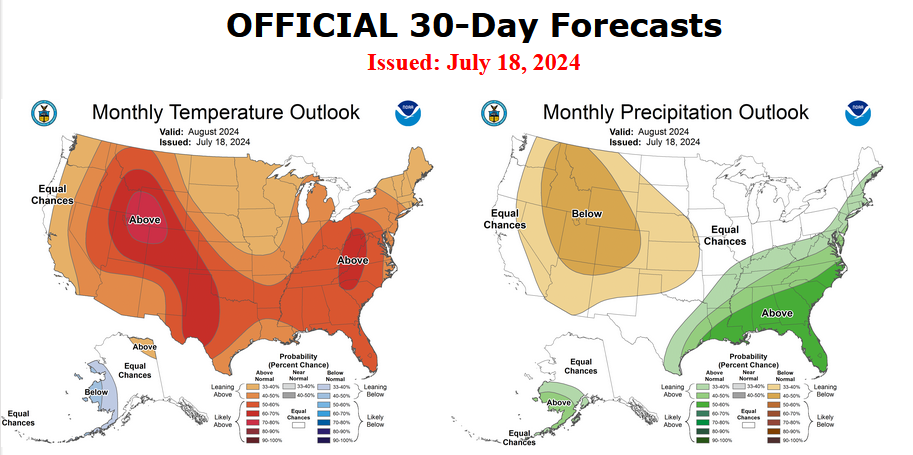
It will be updated on the last day of July.

The top row is what is now called the Mid-Month Outlook for next month which will be updated at the end of this month. There is a temperature map and a precipitation map. The second row is a three-month outlook that includes next month. I think the outlook maps are self-explanatory. What is important to remember is that they show deviations from the current definition of normal which is the period 1991 through 2020. So this is not a forecast of the absolute value of temperature or precipitation but the change from what is defined as normal or to use the technical term “climatology”.
| Notice that the Outlook for next month and the three-month Outlook are fairly similar. This tells us that September and October will be fairly similar to August. |
| The expansion of the area impacted by drought development is extensive but different than what was predicted last month. There is also a large area of drought improvement. |

The full NOAA Seasonal Outlook extends through August/September/October of 2025 (yes that is more than a year out). All of these maps are in the body of the article. Large maps are provided for August and the three-month period August/September/October. Small maps are provided beyond that through August/September/October of 2025 with a link to get larger versions of these maps.
NOAA provides a discussion to support the maps. It is included in the body of this article. In some cases, one will need to click on “read more” to read the full article. For those on my email list where I have sent the url of the article, that will not be necessary.
Here are larger versions of the Temperature and Precipitation Outlook maps for next month.
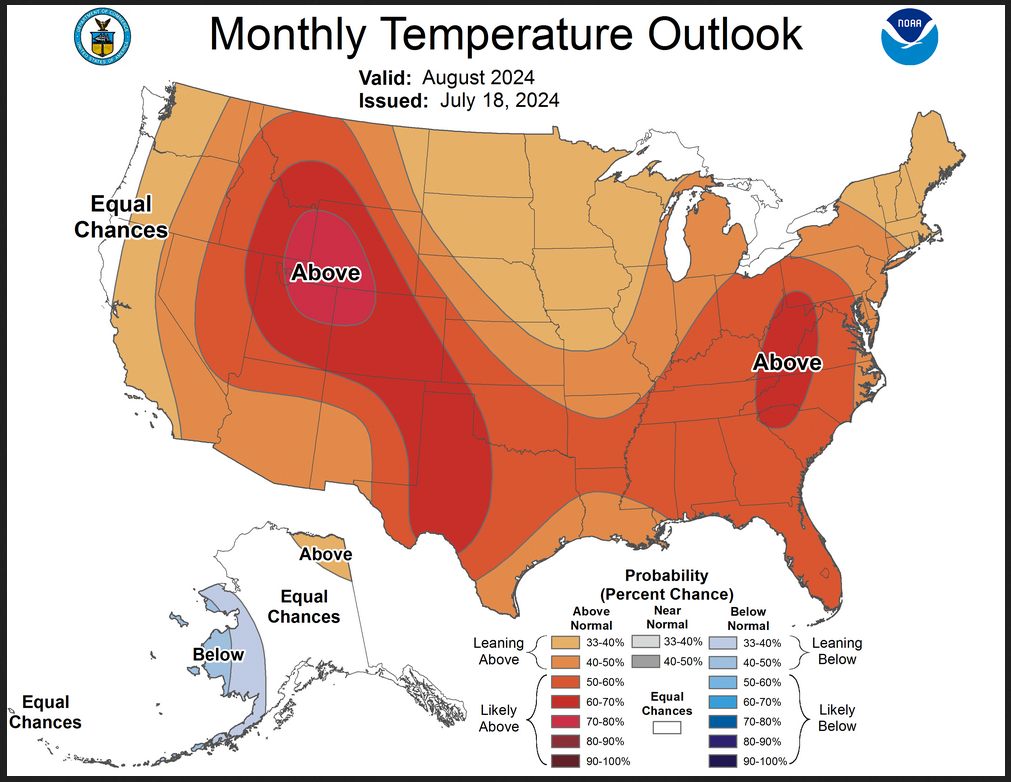
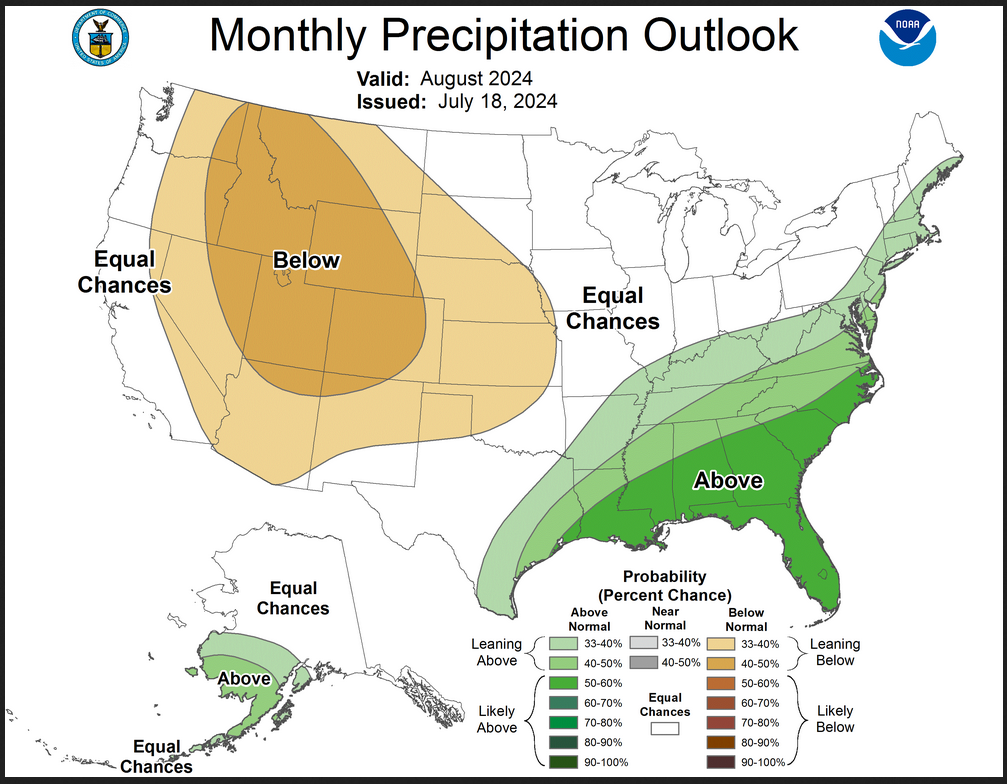
The maps are pretty clear in terms of the outlook.
And here are large versions of the three-month ASO 2024 Outlooks
First temperature followed by precipitation.
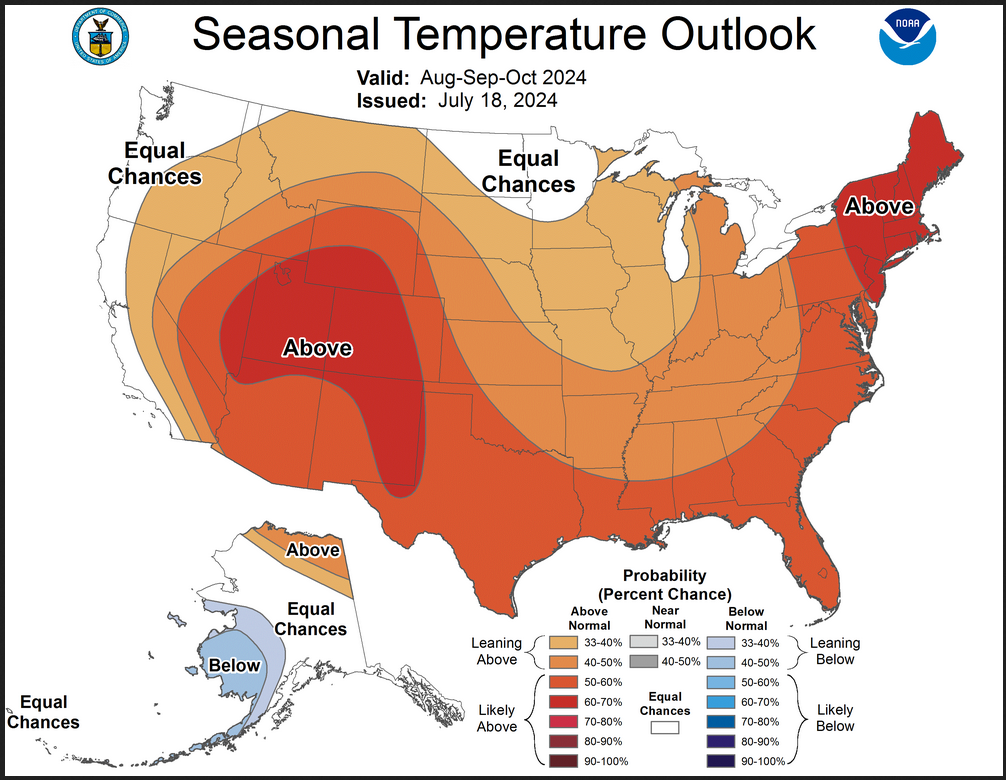
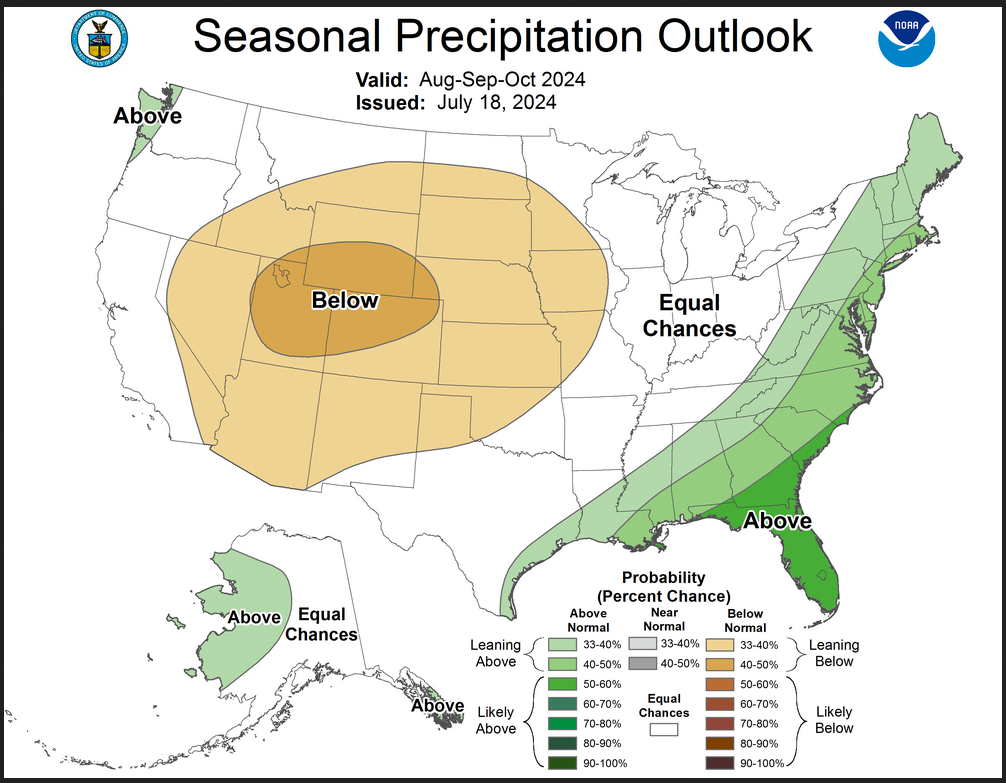
| These maps are larger versions of what was shown earlier. This is a pretty definitive pattern. |
Drought Outlook
| The yellow is the bad news and there is a lot of it. And there is a large area where drought is expected to persist. Overall the level of drought is expected to increase significantly And with a La Nina winter ahead, it is likely to go higher along the Southern Tier. |
Short CPC Drought Discussion
Latest Seasonal Assessment – Following major drought improvement this past winter and into the spring, drought coverage increased during June and early July. Much of this was related to the rapid onset of drought across the Mid-Atlantic and Southeast. Based on above-normal precipitation forecast during the remainder of July and the August-September-October (ASO) precipitation outlook leaning wet, drought removal or improvement is forecast throughout the Mid-Atlantic, Southeast, and Upper Ohio Valley. Areas closer to and along the Central Appalachians are expected to be the slowest to improve during the outlook period.
Persistence is favored for ongoing drought areas of the Great Plains with the ASO outlook leaning dry. Development is most likely across the Central to Northern High Plains due to antecedent dryness and also the likelihood of above-normal temperatures and below-normal precipitation throughout the outlook period. Due to a relatively dry climatology, and consistent with the ASO temperature and precipitation outlooks, drought persistence or development is also forecast across the Northern to Central Rockies, Intermountain West, and parts of the Pacific Northwest and northern California. Based on the ASO precipitation outlook, drought persistence is favored for the Southwest. Development is more likely across Arizona than New Mexico given recent precipitation and late July forecasts.
Removal is forecast for the lingering drought area in southeastern Alaska. Drought persistence or development is favored for Hawaii, while Puerto Rico and the U.S. Virgin Islands are likely to remain drought-free through the end of October.
Looking out Four Seasons.
Twelve Temperature Maps. These are overlapping three-month maps (larger versions of these and other maps can be accessed HERE)

Notice that this presentation starts with Aug/Sep/Oct (ASO) since JJA is considered the near-term and is covered earlier in the presentation. The changes over time are generally discussed in the discussion but you can see the changes easier in the maps.
Comparing the new outlook with the prior Outlook,
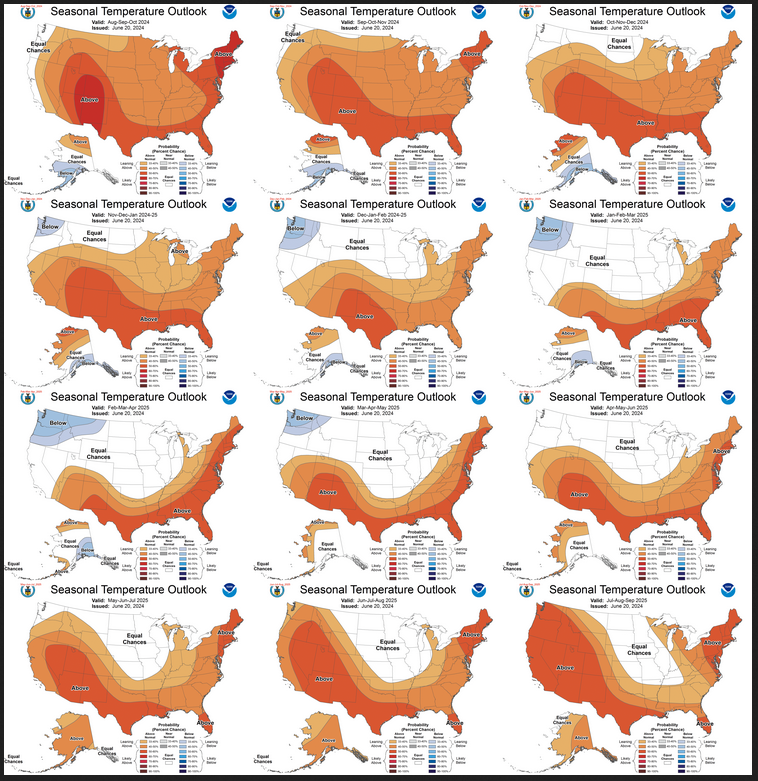
The easiest way to do the comparison is to print out both maps. If you have a color printer that is great but not needed. What I do is number the images from last month 1 – 12 starting with “1” and going left to right and then dropping down one row. Then for the new set of images, I number them 2 – 13. That is because one image from last month in the upper left is now discarded and a new image on the lower right is added. Once you get used to it, it is not difficult. In theory, the changes are discussed in the NOAA discussion but I usually find more changes. It is not necessarily important. I try to identify the changes but believe it would make this article overly long to enumerate them. The information is here for anyone who wishes to examine the changes. I comment below on some of the changes from the prior report by NOAA and important changes over time in the pattern.
| There has not been much of a change since last month. |
Now the Twelve New Precipitation Maps
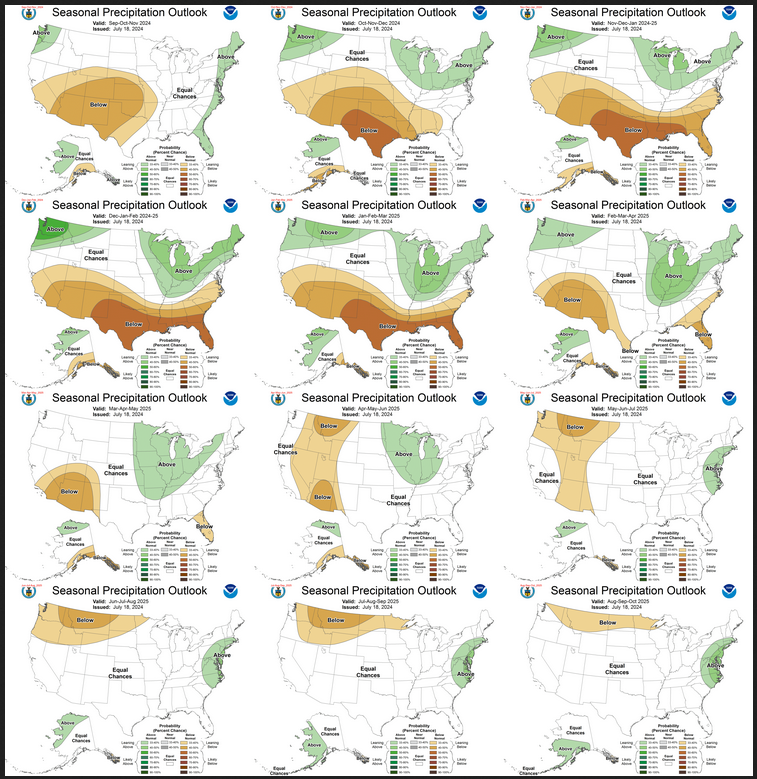
Similar to Temperature in terms of the organization of the twelve overlapping three-month outlooks.
Comparing the new outlook with the prior Outlook,
The maps that were released last month.
A good approach for doing this comparison is provided with the temperature discussion.
| The overall outlook is the same as last month. |
NOAA Discussion
Maps tell a story but to really understand what is going you need to read the discussion. I combine the 30-day discussion with the long-term discussion and rearrange it a bit and add a few additional titles (where they are not all caps the titles are my additions). Readers may also wish to take a look at the article we published last week on the NOAA ENSO forecast. That can be accessed HERE.
I will use bold type to highlight some especially important things. All section headings are in bold type; my comments, if any, are enclosed in brackets [ ].
CURRENT ATMOSPHERIC AND OCEANIC CONDITIONS
ENSO-neutral conditions are currently present in the equatorial tropical Pacific. Observed SST anomalies are -0.2 degrees Celsius in Niño1+2, -0.1 degrees Celsius in Niño3, 0.7 degrees Celsius in Niño4, and 0.3 degrees Celsius in Niño3.4. In general, equatorial SST anomalies are above normal in the western Pacific and below normal in the eastern Pacific. With respect to atmospheric coupling, low-level wind anomalies are easterly over the western equatorial Pacific while upper-level wind anomalies are westerly over the eastern equatorial Pacific. Near to slightly above normal convection is observed over the western Pacific, as indicated by weakly negative outgoing longwave radiation (OLR) anomalies in that region. Overall, the current ocean-atmosphere coupling is indicative of ENSO-neutral conditions.
Equatorial upper-ocean heat anomalies in the eastern Pacific turned negative in January 2024 and have persisted, strengthening and emerging at the surface from late winter into spring. Interestingly, the subsurface negative anomalies became less negative during late spring and early summer, currently approximately -0.5 degrees Celsius. Despite the weakening, the negative anomalies continue to prevail over the eastern half of the equatorial Pacific.
The Madden Julian Oscillation (MJO) is currently weak, with little indication of eastward propagation in fields such as velocity potential and OLR. A robust stationary Wave-1 structure [Editor’s Note: Unusual and may contribute to stagnant conditions at a given locaton] dominates, whose placement has produced upper level convergence over the Western Hemisphere. This convergence has acted to suppress tropical cyclone activity despite very warm SST anomalies in the Atlantic basin. Dynamical model guidance of the MJO is mixed, with only the ECMWF hinting at a possible eastward propagation over the coming weeks. Should such a propagation occur, upper-level conditions will become more favorable for tropical cyclone formation that could impact CONUS.
In the extratropics, coastal SST anomalies are below normal along the western coast of Alaska, with near normal anomalies along Alaska’s southern coast. Near normal SST anomalies are also observed along the West Coast of CONUS. Along the Gulf Coast and East Coast, SST anomalies are above normal. Current soil moisture anomalies are positive in the Upper Mississippi River Valley and eastern portions of the Northern Plains. They are also positive following the track of the remnants of Hurricane Beryl, particularly in eastern Texas. Large negative soil moisture anomalies are evident in the southern and central Appalachians. They are also negative in the Northern Rockies and Intermountain West.
Surface temperatures thus far in July have been characterized by above normal temperatures in western and eastern CONUS, with pockets of near to below normal temperatures in the Central Plains due to transient cold fronts that have advected in cooler air. This overall pattern looks likely to continue through the end of July. Interestingly this pattern is reminiscent of the overall long-term warming trend during summer, which is weakest in the north-central part of CONUS. Precipitation in CONUS has been broadly below normal with a swath of above normal precipitation stretching from the Texas Gulf Coast to Maine due to Hurricane Beryl. An additional area of above normal precipitation has been observed in the southern Mid-Atlantic region. Temperatures in Alaska have been much below normal this July due to above normal precipitation caused by troughing and westerly flow into the state.
PROGNOSTIC DISCUSSION OF SST FORECASTS
The Nino3.4 SST consolidation forecast produced by CPC favors a transition to a La Niña state by ASO 2024 with anomalies less than -0.5 degrees Celsius persisting through February-March-April (FMA) 2025. While forecasted anomalies rebound in the following seasons they are still forecast to remain bounded between -0.5 and 0 degree Celsius through ASO 2025. Consistent with this forecast, the current ENSO Alert System Status is broadcasting a La Niña Watch for the winter of 2024-2025 with the CPC Probabilistic ENSO outlook favoring a 70% chance of La Niña emerging by ASO 2024 and a 79% chance of La Niña during November-December-January (NDJ). With respect to coastal SST anomalies, near to below normal values are forecast by dynamical model guidance to more firmly establish through winter along the southern coast of Alaska and West Coast, consistent with typical upwelling observed during La Niña.
30-DAY OUTLOOK DISCUSSION FOR AUGUST 2024
The August 2024 monthly temperature and precipitation outlooks are based on various climate factors. These include the phase of ENSO, the Madden-Julian Oscillation (MJO), dynamical and statistical model guidance, and boundary conditions such as coastal sea-surface temperatures (SSTs) and recent soil moisture anomalies. Historical temperature and precipitation trends were also considered, as were recent observations and the latest Weeks 3-4 temperature and precipitation outlooks which extend through the 9th of August.
Currently, ENSO-neutral conditions are observed but La Niña is favored to emerge during August-September-October (ASO) 2024 (70% chance) and persist into the Northern Hemisphere winter (79% chance) during November-December-January (NDJ) 2024-25. The latest weekly Niño 3.4 index was +0.3 deg C. Mostly near-normal SSTs prevailed across the near-equatorial eastern and east-central Pacific, while temperatures below the surface in these regions were below-normal. Convection was near-normal to slightly above normal across Indonesia and the vicinity of the Date Line. Collectively, these ocean-atmosphere indicators reflected ENSO-neutral. The MJO signal showed little eastward propagation this past week between the Indian Ocean and Maritime Continent regions, and the OLR plots displayed considerable disorganization. Impacts from both ENSO and the MJO for the month of August are expected to be minor.
The North American Multi-Model Ensemble (NMME) and Copernicus Climate Change Service (C3S) multi-model, also known as the International Multi-Model Ensemble, and their constituent model inputs served as the dynamical basis for the monthly outlooks. The Constructed Analog on Soil Moisture Tool (CA-SMT), ENSO composites and regressions, and historical trends served as the statistical basis for the outlooks. Three consolidation tools were used that skill-weighted and calibrated the dynamical models (NMME-CON), the statistical models (STAT-CON), and a Final-CON which consolidated the other two CONs.
Boundary conditions (coastal SSTs and recent soil moisture anomalies) were also considered in the construction of the monthly temperature and precipitation outlooks for August 2024. SSTs were below-normal near the coasts of northern and western Alaska, mostly near-normal near the West Coast, and above-normal along the Gulf and Atlantic coasts. Recent areas of relatively low soil moisture include the Ohio and Tennessee Valleys, the Central and Southern Appalachians, portions of the Mid-Atlantic region, the Carolinas, the Rio Grande Valley of Texas, and large portions of the northwestern Lower 48 states. In contrast, recent areas of relatively high soil moisture include from the north-central states to the central Great Lakes region (due to frontal activity and thunderstorm clusters), and eastern Texas and much of the Lower Mississippi Valley, primarily due to the passage of former Hurricane Beryl on July 8-9. NOAA’s Atlantic Seasonal Hurricane Outlook calls for a well-above average season this year, which puts the Gulf and East Coasts at an increased risk of impacts from tropical storms and hurricanes.
Temperature
The temperature outlook for August 2024 favors above-normal mean temperatures over nearly all of the contiguous U.S. (CONUS). This is supported by the three consolidation (CON) tools, CFS, and the C3S. A majority of the tools, including the NMME PAC, depict a relative weakness and/or break in the favored warmth across portions of the Great Plains and Mississippi Valley, which is consistent with significant climate variability observed so far this summer. Maximum probabilities favoring above-normal temperatures exceed 70% over portions of the north-central Rockies, supported by much of the model guidance and the expected late-season influence of dry soils. This is a relatively dry time of the year for this area. For the Southwest, the C3S and its inputs are confident of significantly above-normal temperatures and below-normal total precipitation. Depending upon the speed of the anticipated transition of ENSO-neutral to La Niña later this summer, some of the favored dryness across the Southwest may be related to the typically dry La Niña footprint over this region. With other model solutions not being quite as confident as the C3S, suggesting lower probabilities for above-normal temperatures would be prudent across the Southwest. Historical trends also support elevated probabilities for warmer-than-normal temperatures over this region and the southern High Plains during August. Across the north-central states, odds are only slightly tilted towards above-normal temperatures due to several factors. These factors include adequate model and tool support, the expectation of significant variability continuing in the future, and the anticipated continued presence of very moist soils. Over the eastern CONUS, there is plenty of dynamical model support for the favored above-normal temperatures, with limited statistical support. Relatively warm water surrounds the Florida Peninsula and enhances the chances for anomalous warmth. Odds surpass 60% over an area centered on the Central Applachians, in part due to low soil moisture. Near the immediate West Coast, Equal Chances (EC) of below-, near-, and above-normal temperatures are favored in August, attributed to the influence of the marine layer.
For Alaska, odds are tilted towards below-normal temperatures over southwestern sections of the state, largely due to the nearby Bering Sea and its unusually cold water for this time of year. The favored below-normal temperatures are also backed by a regression tool which regresses temperature anomalies against the standardized Niño 3.4 index for the July-September season (with the central month, August, being our target period). For the remainder of the state, a subjective consensus of models and tools suggests a weak tilt towards above-normal temperatures for the northeast portion of the Mainland and EC elsewhere.
Precipitation
The precipitation outlook for August 2024 favors above-normal precipitation for the southeastern third of Texas, much of the Lower Mississippi and Tennessee Valleys, southern Ohio Valley, the Southeast, Southern Appalachian mountains, and from much of the Mid-Atlantic region to southern and central New England. This is supported in large part by the three CON tools, CA-SMT, CFS, and C3S. Maximum probabilities for above-normal precipitation chances surpass 50% for most of the Gulf Coast and Southeast coast states. The last 9 runs of the CFS model favor above-normal precipitation over much of the same general area. This anticipated relatively wet pattern is also deemed judicious given NOAA’s seasonal hurricane outlook which favors a very active Atlantic hurricane season in 2024. In contrast, below-normal precipitation is favored for much of the western half of the CONUS. Most of the support for the relatively dry outlook comes from the three consolidation tools, C3S, CFS, Meteo-France model, and the UKMO model. For several of the last 9 daily CFS runs, wetter-than-normal conditions have been predicted by the CFS model over the northwestern CONUS, which is a significant deviation from most other tools and was therefore discounted. Minimal probabilities favoring below-normal precipitation amounts are indicated across most of Arizona and New Mexico, given the early and consistent start to the Southwest monsoon and potential backdoor cold front activity that often affects New Mexico in particular.
In Alaska, there is a tilt in the odds towards above-normal precipitation for the southwestern Mainland, the Alaska Peninsula, and the eastern Aleutians. This has the support of many of the C3S inputs, including the German and Canadian models (DWD and CMCC, respectively), to name a few. The latest 3 runs of the CFS also lend some support to the favored above-normal precipitation chances across southwestern Alaska. Elsewhere across Alaska and the Lower 48 states, EC is favored.
SUMMARY OF THE OUTLOOK FOR NON-TECHNICAL USERS (Focus on August through October)
Currently, El Niño Southern Oscillation (ENSO) conditions are neutral with above average sea surface temperatures (SSTs) in the west-central Pacific Ocean, near average SSTs in the east-central Pacific Ocean, and below average SSTs in the far eastern Pacific Ocean. A La Niña watch is currently in effect and is favored to develop during August-September-October (ASO; 70% chance) and persist into the Northern Hemisphere winter 2024-25 (79% chance) during November-December-January (NDJ). As summer wanes and winter approaches, the overall temperature and precipitation patterns across the contiguous U.S. (CONUS) and Alaska are expected to transition to those associated with typical La Niña impacts. For the remainder of summer and early fall 2024 and again late spring and summer 2025, the overall outlooks resemble long-term decadal trends.
Temperature
The ASO 2024 Temperature Outlook favors above normal temperatures for much of the contiguous United States (CONUS), with the strongest probabilities reaching 60 to 70% over parts of the Interior West and New England. Above normal temperature probabilities of 50 to 60% are forecast over the Gulf and Southeast Coasts, including Florida. In contrast, equal-chances (EC) of above-, near-, or below-normal temperatures are favored over the West Coast of CONUS and portions of the Northern Plains. Below normal temperatures are indicated over southwestern Alaska, transitioning to above normal over the northeast part of the state.
Precipitation
Below normal precipitation is favored over parts of the western and central CONUS in ASO 2024, except over the West Coast where EC is favored. Above normal precipitation is forecast for southeastern Texas, the Gulf States, and along the Eastern Seaboard into New England with the highest probabilities (50 to 60%) centered over Florida. Above normal precipitation is also indicated over western Alaska. For the remaining areas of CONUS, EC is forecast.
BASIS AND SUMMARY OF THE CURRENT LONG-LEAD OUTLOOKS
PROGNOSTIC TOOLS USED FOR U.S. TEMPERATURE AND PRECIPITATION OUTLOOKS
A suite of multiple statistical and dynamical forecast tools is used to produce the temperature and precipitation outlooks for ASO 2024 to ASO 2025.
Dynamical model forecasts from the Copernicus (C3S) and North American Multi-Model Ensemble (NMME) are used for the first three and six leads respectively, as well as individual model forecasts from the Climate Forecast System version 2 (CFSv2) and European Centre for Medium Range Weather Forecasts (ECMWF) models as available. The objective, historical skill weighted consolidation that combines both dynamical and statistical forecast tools was also considered throughout all leads. The Calibration, Bridging and Merging (CBaM) tool anchored to the NMME forecasts and “bridged” to the Niño3.4 index is also utilized. In addition to the dynamical model guidance, coastal SSTs and soil moisture anomalies are considered at early leads.
Because La Niña is favored to develop by and persist through winter 2024-25, La Niña impacts are considered the dominant influence on the forecast from ASO 2024 through March-April-May (MAM) 2025. These impacts differ by region, variable, and season. To determine these impacts, La Niña composites and correlations of temperature and precipitation with the Niño3.4 region were employed via statistical tools such as the SST-based Constructed Analog (CA). Long-term decadal temperature and precipitation trends also played a role during many of the seasons, especially beyond lead 6 when dynamical model guidance is unavailable. Longer lead outlooks, beginning in April-May-June (AMJ) 2025 are based primarily on decadal temperature and precipitation trends.
PROGNOSTIC DISCUSSION OF OUTLOOKS – ASO 2024 TO ASO 2025
TEMPERATURE
The ASO 2024 Temperature Outlook depicts elevated probabilities of above normal temperatures throughout much of CONUS. The highest probabilities reach 60-70% north of the Four Corners region and New England where model guidance was in good agreement and decadal temperature trends are strongly positive. Equal Chances (EC) of above-, near-, or below-normal temperature are posted for the immediate West Coast where coastal SSTs are expected to be below normal, leading to a potential maritime cooling impact. EC and a slight tilt in the odds toward above normal temperatures are forecast in the more interior regions of the Pacific Northwest, as La Niña impacts are expected to emerge by late in the season. Farther east, in Northern Plains and portions of the Midwest and Upper Mississippi River Valley, a combination of pattern persistence, less positive decadal temperature trends , and high climatological variance, particularly in October, has led to regions of EC and reduced odds of above normal temperatures. Furthermore, several models, such as the CFS, also depict a weakness in the temperature field in this region. 50 to 60% probabilities of above normal temperatures are favored along the Gulf Coast, Florida, and the Southeast Coast due to elevated SSTs and model agreement. In Alaska, above normal temperatures are forecast along the eastern North Slope due to decadal trends of sea ice loss. Below normal temperatures are favored in southwestern Alaska and the Aleutians due to below normal SSTs currently observed along with support from the CFS and NMME. Overall confidence in the temperature outlook for ASO 2024 is medium. While August and September generally have low climatological variance, that is not the case in October, where anomalies in that month can both overwhelm the trend and the combined anomalies in the prior two months. Further uncertainty is introduced due to the potential impact of tropical cyclones, especially in October when they can potentially usher in much cooler air on their western flanks.
The temperature outlooks for September-October-November (SON) 2024 and October-November-December (OND) 2024 generally depict a transition from the summertime state which is dominated by decadal temperature trends toward one that is more typical of La Niña. The overall pattern is consistent with ASO 2024, with the highest probabilities for above normal temperatures in the West and New England. However, progressing through these seasons, the areas of EC and lower probabilities of above normal temperatures generally expand in the Pacific Northwest, Northern Plains, and Midwest. In fact, a small tilt in the odds toward below normal temperatures is forecast for the extreme northwestern corner of Washington state in OND 2024. The temperature outlook in Alaska increases the odds of above normal temperatures across all of the North Slope and shifts the highest odds of below normal temperatures to the entire southern third of the state, consistent with a transition to La Niña.
Winter and early spring 2024-2025 temperatures are expected to be driven by La Niña impacts. The forecasts generally tilt the probabilities toward below normal temperatures over the Pacific Northwest and stretching into parts of the Central Plains from NDJ 2024-2025 through MAM 2025, with above normal temperatures over the southern tier of CONUS. For longer leads beginning in AMJ 2025 through ASO 2025, the outlook resembles decadal temperature trends , where above normal temperatures are favored across much of CONUS except parts of the Northern Plains where trends are weaker and even negative during the spring months. For Alaska, the temperature outlook progressively favors above normal temperatures over below normal temperatures due to long-term trends and the waning influence of La Nina into the summer months.
PRECIPITATION
The ASO 2024 Precipitation Outlook depicts elevated odds of below normal precipitation over much of the interior of the West, with the highest odds centered over Utah, Colorado, and Wyoming. Probabilities to the south of this region are relatively muted compared to the previous outlook due to positive precipitation anomalies that have occurred thus far this summer in portions of Arizona, New Mexico, and southern Colorado. Nonetheless, below normal precipitation is still largely supported by dynamical model guidance such as the NMME, C3S, and CFS along with the growing influence of La Niña and weaker than normal tropical cyclone activity in the eastern Pacific. A small area of above normal precipitation is favored in the northwestern corner of Washington state as La Niña begins to impact the region later in the season. Along the Gulf Coast and East Coast, above normal probabilities of precipitation are posted consistent with the 2024 Atlantic Hurricane Season Outlook for above normal tropical cyclone activity. The highest probabilities reach 50 to 60% over Florida. EC is depicted in the remainder of CONUS, due to model disagreement and no strong decadal trends . Above normal precipitation is slightly favored in western Alaska due to anticipated onshore flow, which is a persistence of the current pattern, and the ECMWF. Overall confidence in the precipitation outlook for ASO 2024 is low to medium. Uncertainty is introduced due to the potential impact of tropical cyclones and their eventual tracks.
The precipitation outlook in ASO 2024 largely persists into SON 2024 before transitioning by winter toward the canonical La Niña precipitation pattern. This pattern features elevated odds of below normal precipitation along the southern tier of CONUS from southern California to the Southeast. Above normal precipitation is favored over the Pacific Northwest and Great Lakes. At longer leads, including spring and summer 2025, the La Niña pattern fades and is replaced by large swaths of EC for much of CONUS. Only the Mid-Atlantic and northern portions of the West have a small tilt in their odds toward above and below normal precipitation, respectively, due to decadal trends . Above normal precipitation is favored for parts of the North Slope of Alaska, also due to decadal trends , shifting to the southern coast by ASO 2025.
The key piece of information used by NOAA follows.
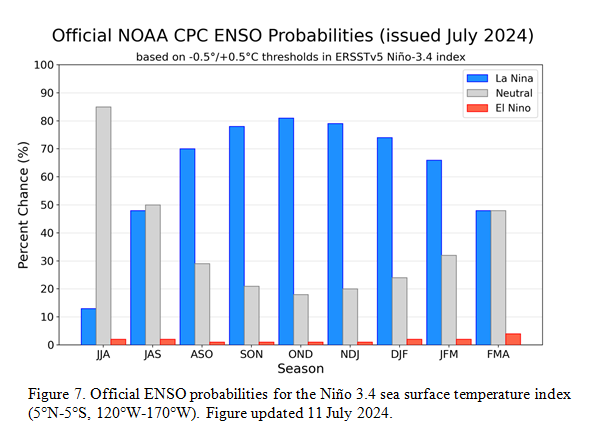
| It looks like ENSO is Neutral now and by summer we should be in La Nina which continues through the forecast period shown here but the full forecast in this article goes beyond next winter. This type of graphic does not show how strong an El Nino or a La Nina is likely to be. What is forecast is a La Nina that is stronger than a marginal La Nina but not very strong. |
Resources
Other Reports and Information
The Wildfire Report can be accessed HERE
–
| I hope you found this article interesting and useful. |
–
